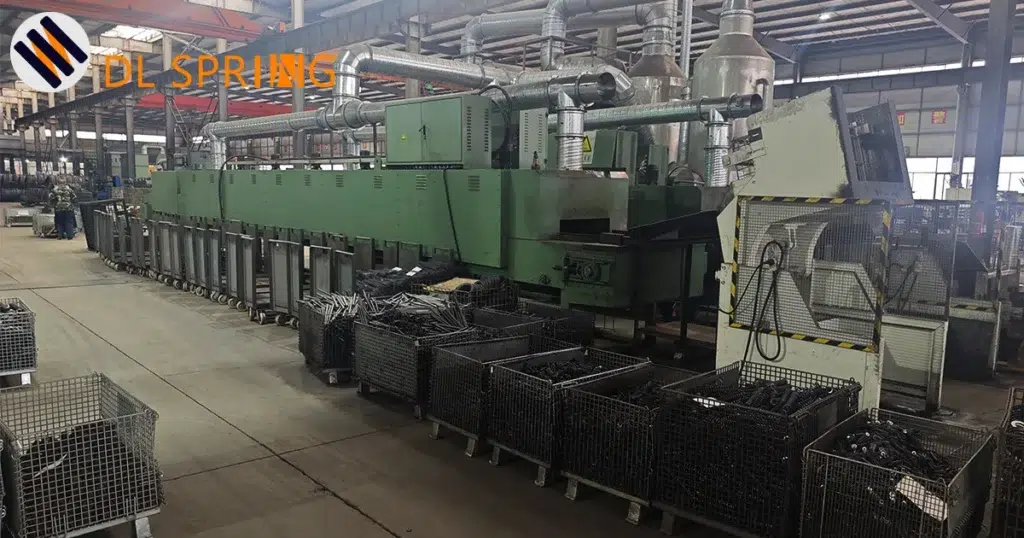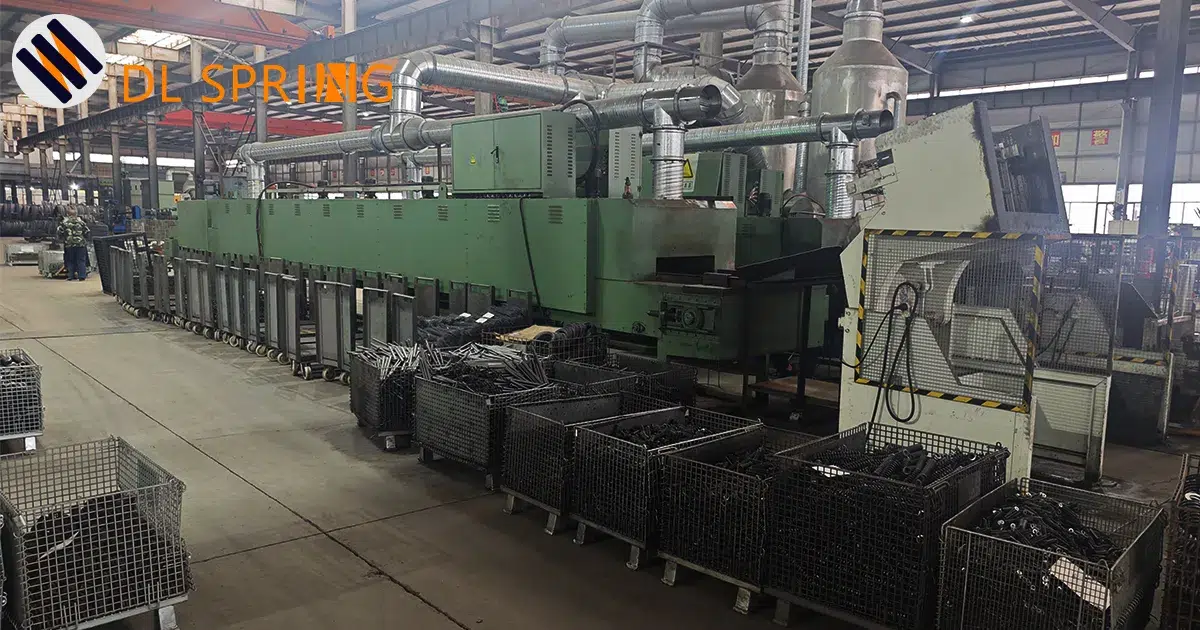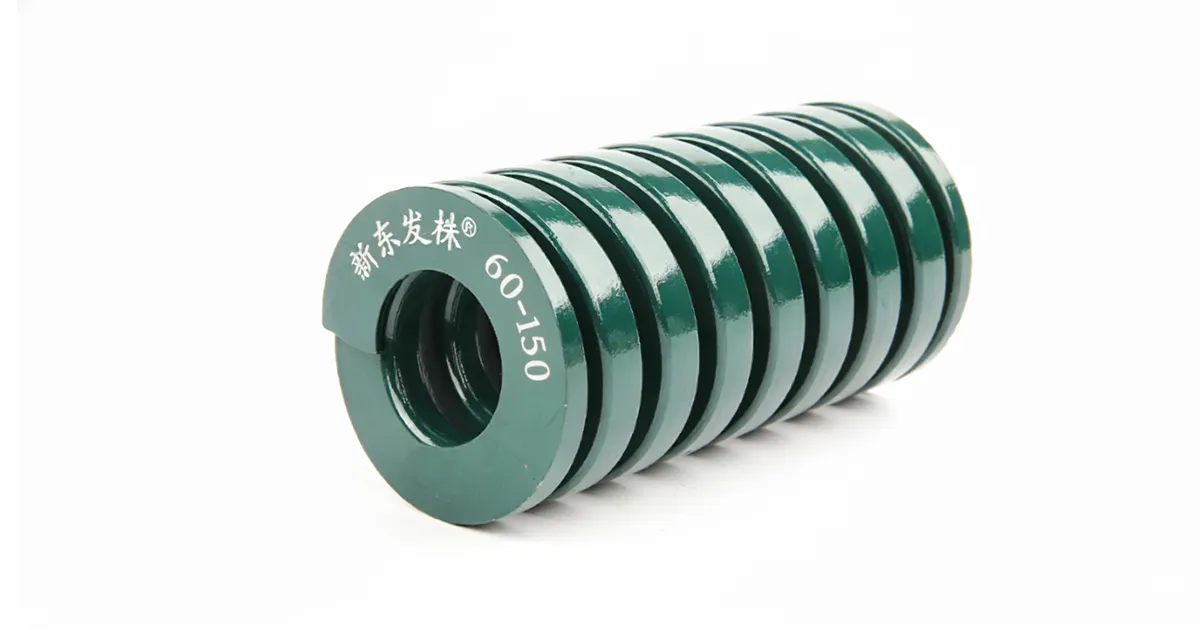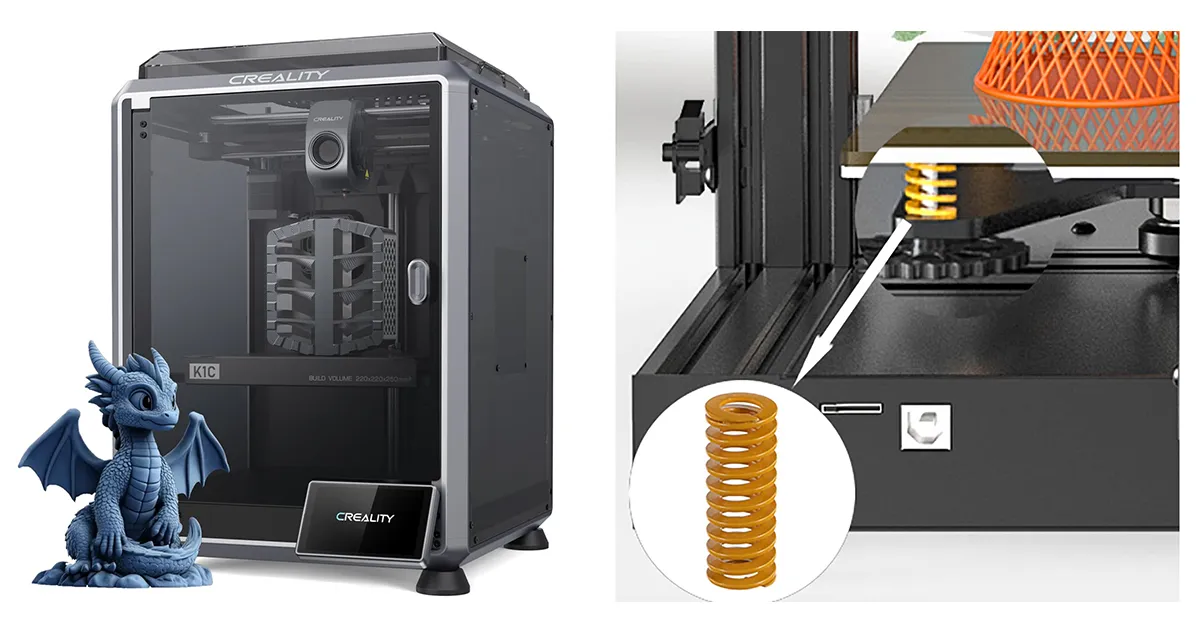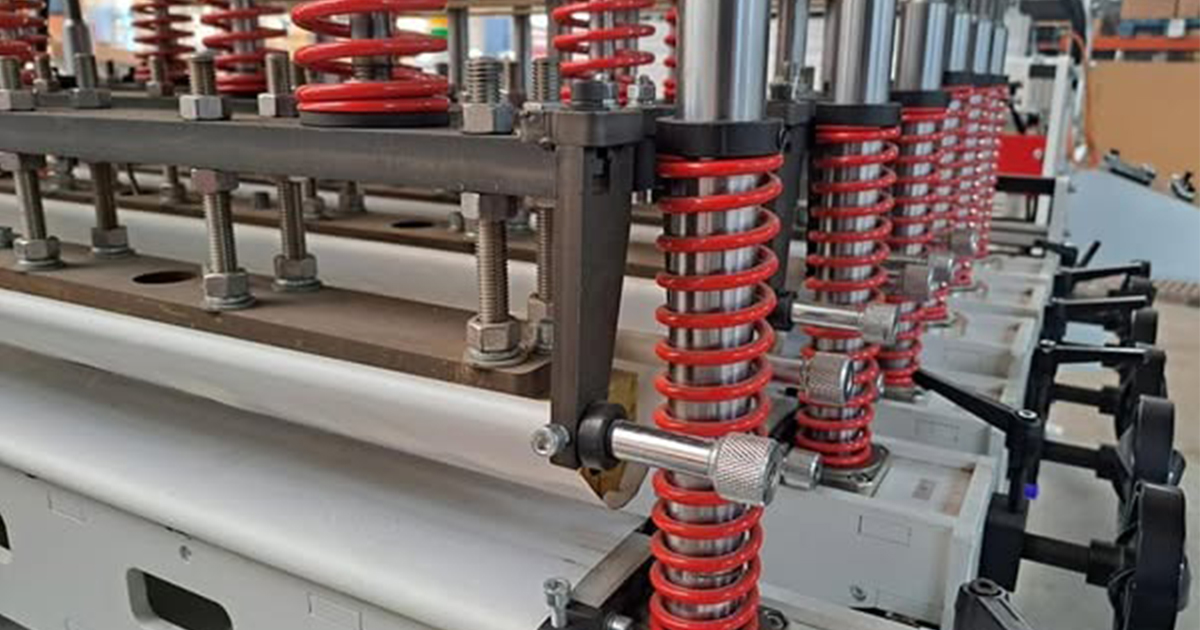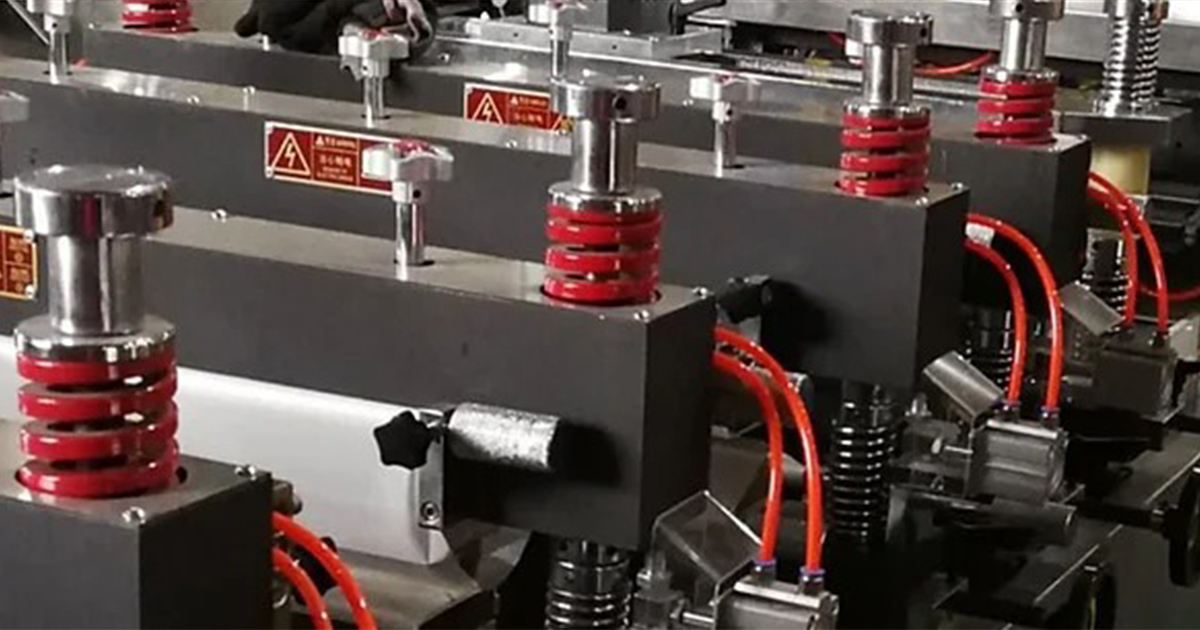In the precision-driven world of spring manufacturing, achieving dimensional stability and optimal mechanical properties is paramount. Whether you’re producing compression springs, torsion springs, or extension springs for demanding applications, one critical process stands between raw production and reliable performance: stress relief annealing.
Springs manufactured through cold forming processes—including cold coiling and cold drawing—inherently develop significant internal stresses within the metal wire. These residual stresses, if left untreated, can lead to dimensional instability, premature failure, and unpredictable performance during service life. This is where stress relief annealing, also known as stress relief heat treatment or stress relief tempering, becomes indispensable.
Stress relief annealing is a controlled heat treatment process that eliminates internal stresses accumulated during cold forming operations. By carefully heating springs to specific temperatures and holding them for precise durations, manufacturers can stabilize dimensions, improve mechanical properties, and ensure consistent performance across thousands of load cycles.
This comprehensive guide explores the science, parameters, equipment, and best practices of stress relief annealing for various spring types and materials, providing manufacturers and engineers with actionable insights for optimizing their spring production processes.
The Purpose and Benefits of Stress Relief Annealing
Why Stress Relief Annealing is Essential
Springs manufactured using cold forming techniques undergo significant mechanical deformation during production. This cold working process introduces complex internal stresses throughout the wire material, creating a network of strain that affects the spring’s structural integrity and performance characteristics.
The four primary objectives of stress relief annealing are:
1. Eliminating Internal Stresses from Cold Forming
During cold coiling and cold forming operations, the metal wire experiences extreme bending and torsional forces. These forces create microscopic dislocations and residual stresses within the crystalline structure of the metal. Without proper heat treatment, these stresses remain locked within the material, creating potential failure points and inconsistent mechanical behavior.
Stress relief annealing allows the metal’s atomic structure to relax and reorganize, releasing accumulated internal stresses and creating a more uniform material state.
2. Stabilizing Dimensions During Service Life
One of the most critical challenges in spring manufacturing is dimensional stability. Springs that haven’t undergone proper stress relief annealing may experience dimensional changes during subsequent manufacturing processes or while in service. This can result in:
- Unacceptable variations in outer diameter
- Changes in free length
- Inconsistent coil spacing
- Loss of load-bearing capacity
Properly executed stress relief annealing ensures that springs maintain stable dimensions throughout their operational life, even under varying load conditions and temperature fluctuations.
3. Improving Tensile Strength and Elastic Limit
Stress relief annealing doesn’t just eliminate problems—it actively enhances spring performance. The heat treatment process improves two critical mechanical properties:
- Tensile Strength: The maximum stress the material can withstand before failure
- Elastic Limit: The maximum stress under which the material returns to its original shape
These improvements translate directly to springs that can handle higher loads, endure more cycles, and maintain their performance characteristics over extended periods.
4. Dimensional Control Through Heat Treatment
When springs are mounted on fixtures or jigs during stress relief annealing, manufacturers can actually control and adjust spring dimensions during the heat treatment process. This capability is particularly valuable for:
- Achieving tight tolerance requirements
- Correcting minor dimensional variations from the coiling process
- Ensuring batch-to-batch consistency
This level of control transforms stress relief annealing from a necessary process step into a precision manufacturing tool.
Heat Treatment Equipment for Spring Stress Relief
Watch Our Stress Relief Annealing Machine in Action
See our state-of-the-art stress relief annealing equipment in operation!
This video showcases our continuous hot air circulation electric furnace processing freshly coiled springs. Watch how our automated system ensures precise temperature control (170°C – 460°C), uniform heat distribution, and consistent quality across every batch.
What you’ll see in the video:
- ✓ Automated spring loading and processing workflow
- ✓ Continuous hot air circulation technology in action
- ✓ Integrated production line (coiling to annealing)
- ✓ Professional heat treatment process control
- ✓ Quality assurance procedures
Subscribe to Our YouTube Channel
The selection of appropriate heat treatment equipment significantly impacts the efficiency, consistency, and quality of stress relief annealing. Modern spring manufacturers typically employ several types of furnaces, each with distinct advantages and applications.
1. Continuous Hot Air Circulation Electric Furnaces
Advantages:
- Precise temperature control with minimal variation
- Energy-efficient operation
- Excellent for high-volume production
- Automated coiling and stress relief integration
This equipment type has become increasingly popular in modern spring manufacturing facilities. When positioned directly in front of the coiling machine, these furnaces enable a seamless workflow where springs move automatically from coiling to stress relief treatment, creating an integrated production line.
The continuous circulation of hot air ensures uniform temperature distribution throughout the treatment chamber, eliminating hot spots and cold zones that could compromise spring quality.
Best Applications:
- Mass production of standard spring types
- Carbon steel spring wire and heavy-duty galvanized steel wire
- Music wire/piano wire
2. Hot Air Circulation Furnaces and Box-Type Electric Furnaces
These furnace types offer uniform temperature distribution but typically require longer holding times compared to nitrate salt bath furnaces. While the extended treatment duration may seem like a disadvantage, the longer holding time at lower temperatures can actually provide benefits for certain spring materials.
Characteristics:
- Relatively uniform heating
- Longer processing times
- Lower capital equipment costs
- Suitable for batch processing
3. Nitrate Salt Bath Furnaces
Nitrate salt bath furnaces represent a specialized heat treatment solution typically custom-manufactured by spring producers to meet specific production requirements.
Key Advantages:
- Extremely rapid heating rates
- Short holding times
- Excellent temperature uniformity
Critical Considerations:
- Temperature non-uniformity in the liquid bath can cause surface defects on oil-quenched tempered spring steel wire
- Springs must undergo water quenching and thorough cleaning after treatment
- Immersion time in the salt bath should not exceed several minutes to prevent rust formation
Important Safety Note: When using electric furnaces for stress relief annealing, the holding time is significantly longer than with nitrate salt bath furnaces. This extended duration ensures complete stress relief throughout the spring’s cross-section.
Equipment Selection Criteria
When selecting heat treatment equipment, manufacturers should consider:
- Production volume and throughput requirements
- Spring material types and wire specifications
- Available floor space and integration with existing production lines
- Energy costs and efficiency requirements
- Quality control and temperature uniformity needs
Stress Relief Annealing Temperature and Time Parameters
Achieving optimal results from stress relief annealing requires precise control of both temperature and time. The correct parameters depend on multiple factors, including wire material, wire diameter, spring type, and intended application.
Understanding the Temperature Range
Stress relief annealing temperatures typically fall within the range of 170°C to 460°C (338°F to 860°F). The fundamental principle guiding temperature selection is straightforward: use the lowest temperature that effectively achieves stress relief.
Why lower temperatures when possible?
For materials with identical chemical composition and processing history:
- Higher temperatures provide more complete stress relief
- However, some materials become softer and less elastic at elevated temperatures
- Lower temperatures require longer holding times but preserve material hardness
Material-Specific Temperature Considerations
The optimal temperature varies significantly based on spring material:
- Carbon steel spring wire: Requires relatively high temperatures
- Oil-quenched tempered spring steel wire and alloy steel springs: Generally need higher temperature ranges
- Austenitic stainless steel wire: Operates at higher temperatures (360°C – 460°C)
- Silicon copper wire and phosphor bronze wire: Lower temperature ranges (170°C – 220°C)
Special Consideration for Coil Springs:
For helical compression springs and helical extension springs, manufacturers should typically select temperatures 3-5°C higher than standard values with correspondingly extended holding times.
Comprehensive Temperature and Time Parameters
The following table provides detailed stress relief annealing parameters for various spring materials and wire specifications:
| Spring Material Type | Wire Diameter (mm) | Temperature (°C) | Holding Time (min) | Cooling Method |
|---|---|---|---|---|
| Carbon Steel Spring Wire | < 1 | 240 – 260 | 10 – 20 | Air or Water |
| > 1 – 2 | 260 – 280 | 15 – 25 | ||
| Heavy-Duty Galvanized Steel Wire | > 2 – 3.5 | 280 – 300 | 20 – 30 | |
| Music Wire | > 3.5 – 6 | 300 – 320 | 20 – 30 | |
| > 6 – 8 | 320 – 340 | 25 – 35 | ||
| Oil-Quenched Tempered Spring Steel Wire | ≤ 2 | 360 – 420 | 20 – 30 | Air or Water |
| > 2 | 380 – 460 | 25 – 35 | ||
| Austenitic Stainless Steel Wire | < 3 | 280 – 320 | 20 – 30 | Air or Water |
| > 3 | 320 – 360 | 30 – 40 | ||
| Silicon Copper Wire / Phosphor Bronze Wire | ≤ 1 | 170 – 180 | 40 | Air or Water |
| > 1 – 2.6 | 180 – 200 | 60 | ||
| > 2.6 | 180 – 220 | 60 – 90 | ||
| Beryllium Copper Wire | ≤ 1.8 | 240 – 300 | 60 | Air or Water |
| > 1.8 – 2.6 | 240 – 310 | 60 – 90 | ||
| > 2.6 | 280 – 310 | 60 – 90 |
The Relationship Between Temperature and Initial Tension
For extension springs where initial tension is a critical parameter, the stress relief temperature directly impacts the retained tension force. The relationship follows a predictable pattern:
- Lower temperatures and shorter times = Greater retained initial tension
- Higher temperatures and longer times = Reduced initial tension
Practical Application:
When high initial tension is required in the finished spring, manufacturers can reduce the stress relief temperature to as low as 180°C. However, it’s essential to note that helical extension springs’ initial tension is primarily controlled during the coiling process, with stress relief annealing serving only an auxiliary adjustment function.
Secondary Stress Relief for Coil Springs and Torsion Springs
For helical extension springs and helical torsion springs requiring a second stress relief treatment, the temperature for the secondary treatment should be approximately 20°C lower than the first treatment, with a correspondingly shorter holding time.
Post-Treatment Temperature Requirements
After undergoing drawing processes or other cold working operations, springs requiring additional stress relief should be treated at temperatures 20°C higher than standard recommended values to compensate for the additional work hardening.
Impact on Spring Diameter and Total Coils
One of the less obvious but critically important effects of stress relief annealing involves dimensional changes to the spring itself. Understanding and predicting these changes is essential for maintaining tight tolerances and achieving consistent production quality.
Diameter Reduction Phenomenon
Springs manufactured from carbon steel wire, heavy-duty galvanized steel wire, and music wire undergo a predictable dimensional change during stress relief annealing: the outer diameter decreases while the total number of coils increases.
This phenomenon occurs because:
- Internal stresses are released during heat treatment
- The spring wire naturally relaxes into a lower-energy configuration
- The spring “tightens” slightly, reducing its diameter
Practical Implications:
The diameter reduction is directly proportional to:
- The coiling ratio / spring index – higher ratios produce greater diameter changes
- The magnitude of diameter reduction is greater for springs with larger coiling ratios
Mathematical Prediction of Dimensional Changes
To maintain production control and predict spring dimensions after stress relief treatment, manufacturers can use established empirical formulas:
Diameter Reduction Calculation:
ΔD₂ = Ki · C · D₂ · T
Where:
- ΔD₂ = Diameter reduction after stress relief treatment
- Ki = Deformation coefficient related to coiling method
- For solid-core coiling: Ki = 6 × 10-6
- For coreless coiling: Ki = 4.4 × 10-6
- C = Spring index (coiling ratio)
- D₂ = Outer diameter before treatment
- T = Stress relief annealing temperature (°C)
Total Coil Number Increase Calculation:
Δn = (1 + D₂/(D₂ + ΔD₂)) · n₁
Where:
- Δn = Increase in total coil number
- n₁ = Original number of coils
- D₂ = Original outer diameter
- ΔD₂ = Diameter reduction (calculated above)
Application in Production Planning
These formulas enable manufacturers to:
- Predict final dimensions before heat treatment
- Adjust coiling parameters to compensate for anticipated diameter reduction
- Conduct sample testing to validate calculations before batch production
- Maintain tight tolerances by accounting for dimensional changes
Important Note: After validating calculations through sample testing, manufacturers can confidently proceed with mass production, knowing that dimensional changes will fall within predicted ranges.
Special Considerations for Alloy Steels
For springs manufactured from copper alloys and austenitic stainless steel wire, diameter changes after stress relief annealing are generally more pronounced. Manufacturers should:
- Maintain adequate tolerances in initial coiling operations
- Conduct comprehensive sample testing before batch production
- Consider using holding fixtures to control final dimensions during heat treatment
Best Practices and Process Control
Achieving consistent, high-quality results from stress relief annealing requires more than just correct temperature and time parameters. Manufacturers must implement comprehensive process controls and best practices throughout the heat treatment operation.
Auxiliary Tools and Fixtures
When to Use Fixtures:
Springs requiring dimensional adjustments during stress relief annealing should be mounted on appropriate auxiliary tools and fixtures. This approach provides:
- Precise dimensional control during heat treatment
- Correction of minor coiling variations
- Consistent batch-to-batch results
- Ability to achieve tighter tolerances
Fixture Design Considerations:
- Must withstand treatment temperatures without deformation
- Should allow uniform heat circulation around springs
- Must be easy to load and unload for production efficiency
- Should be designed for the specific spring geometry being produced
Special Handling for Oil-Quenched Tempered Springs
Springs manufactured from oil-quenched tempered spring steel wire require special attention after nitrate salt bath furnace treatment:
Critical Process Steps:
- Immediate water quenching after removal from salt bath
- Thorough cleaning to remove all salt residues
- Immersion time limitation – never exceed several minutes in the salt bath
- Rust prevention – salt residues accelerate corrosion if not completely removed
Why This Matters:
Failure to properly clean and quench these springs can result in:
- Surface corrosion and pitting
- Reduced fatigue life
- Compromised spring performance
- Aesthetic defects
Temperature Control Strategies
For Different Spring Types:
The required precision and approach to temperature control varies by spring configuration:
- Helical compression springs: Standard temperature parameters with possible 3-5°C increase for critical applications
- Helical extension springs: Careful temperature selection to preserve required initial tension
- Torsion springs: Similar approach to extension springs with attention to rotational stress distribution
Monitoring and Documentation:
Implement comprehensive temperature monitoring:
- Use calibrated thermocouples positioned throughout the furnace
- Maintain detailed temperature records for each batch
- Establish temperature uniformity surveys on regular intervals
- Document holding times with precision
Quality Assurance Measures
Pre-Treatment Inspection:
- Verify spring dimensions before heat treatment
- Check for surface defects or damage
- Ensure springs are clean and free from contaminants
Post-Treatment Verification:
- Dimensional measurement and comparison to specifications
- Visual inspection for surface defects
- Mechanical testing of sample springs from each batch
- Documentation of any dimensional changes
Process Validation:
For new spring designs or material changes:
- Conduct comprehensive sample testing with various temperature/time combinations
- Measure and document dimensional changes
- Perform mechanical property testing
- Validate performance under actual service conditions
- Only proceed to mass production after complete validation
Energy Efficiency and Cost Optimization
While maintaining quality standards, manufacturers should also consider:
- Batch size optimization to maximize furnace utilization
- Heat treatment scheduling to minimize furnace startup/shutdown cycles
- Preventive maintenance to ensure consistent furnace performance
- Energy monitoring to identify efficiency improvement opportunities
Cixi Dili Spring Co., Ltd.: Your Trusted Spring Manufacturing Partner
Excellence in Spring Manufacturing Since Establishment
At Cixi Dili Spring Co., Ltd. , we combine decades of spring manufacturing expertise with cutting-edge production technology to deliver precision-engineered springs for diverse industrial applications worldwide.
Our Core Competencies
Comprehensive Spring Product Portfolio:
We specialize in manufacturing a complete range of spring products:
- Mold Springs (Die Springs)
- JIS Standard Springs (Japanese Industrial Standards)
- US Standard Springs (American specifications)
- Custom mold springs for plastic injection molding, stamping dies, and precision tooling
- Torsion Springs
- Precision-wound torsion springs for automotive, electronics, and machinery applications
- Custom designs based on torque and angular deflection requirements
- Compression Springs
- Heavy-duty compression springs for industrial equipment
- Precision compression springs for sensitive applications
- Custom spring rates and load specifications
- Extension Springs
- Standard and custom extension springs with precise initial tension control
- Various hook and loop end configurations
Our Manufacturing Capabilities
Advanced Production Technology:
Our state-of-the-art manufacturing facility features:
- Modern CNC spring coiling machines for precision and consistency
- Integrated stress relief annealing systems with continuous hot air circulation furnaces
- Automated quality control systems ensuring dimensional accuracy
- Heat treatment capabilities across the full temperature range (170°C – 460°C)
- Surface treatment facilities including galvanizing, powder coating, and specialized finishes
Material Expertise:
We work with a comprehensive range of spring materials:
- Carbon steel spring wire
- Oil-quenched tempered spring steel
- Stainless steel (austenitic and martensitic grades)
- Music wire (piano wire)
- Beryllium copper
- Phosphor bronze
- Silicon copper
- Special alloys for high-temperature applications
Quality Assurance and Certifications
Commitment to Quality:
Quality is not just a goal at Cixi Dili Spring—it’s embedded in every stage of our manufacturing process:
- International Standards Compliance: All products manufactured according to ISO, JIS, DIN, and ASTM standards
- Rigorous Testing Protocols: Comprehensive dimensional, mechanical, and fatigue testing
- Material Certification: Full material traceability and certification documentation
- Process Control: Statistical process control (SPC) throughout production
- Quality Documentation: Complete inspection reports and compliance certificates
Industry Certifications:
Our facility maintains certifications demonstrating our commitment to quality and continuous improvement:
- ISO 9001 Quality Management System
- Industry-specific certifications for automotive and aerospace applications
- Environmental management compliance
Custom Manufacturing Excellence
Your Vision, Our Expertise:
We understand that standard springs don’t always meet unique application requirements. That’s why we offer comprehensive custom manufacturing services:
Custom Manufacturing Based on:
- Customer-provided samples
- Engineering drawings and specifications
- Application requirements and performance parameters
- Material and finish specifications
Our Engineering Support:
Our experienced engineering team provides:
- Design consultation and optimization recommendations
- Material selection guidance
- Finite element analysis (FEA) for critical applications
- Prototype development and testing
- Production scalability assessment
Complete Production System
Integrated Manufacturing Workflow:
From raw material to finished product, we maintain complete control over the manufacturing process:
- Material Inspection: Verification of material chemistry and mechanical properties
- Precision Coiling: CNC-controlled spring forming with tight tolerances
- Stress Relief Annealing: Optimized heat treatment for dimensional stability and performance
- Surface Treatment: Protective and decorative finishes as required
- Quality Inspection: Comprehensive dimensional and functional testing
- Packaging and Delivery: Secure packaging and reliable logistics
Global Reach, Local Service
While headquartered in Cixi, China, we serve customers worldwide across multiple industries:
- Automotive and transportation
- Industrial machinery and equipment
- Electronics and telecommunications
- Aerospace and defense
- Medical devices and instrumentation
- Consumer products
Our commitment to customer satisfaction extends beyond product delivery. We provide:
- Responsive technical support
- Flexible order quantities (prototypes to mass production)
- Competitive pricing without compromising quality
- Reliable delivery schedules
- After-sales support and consultation
Why Choose Cixi Dili Spring?
- Technical Expertise: Decades of experience in spring manufacturing and heat treatment optimization
- Quality Assurance: Rigorous quality control at every production stage
- Customization Capability: Flexible manufacturing to meet unique requirements
- Competitive Pricing: Efficient production systems delivering value without sacrificing quality
- Reliable Partnership: Long-term relationships built on trust and performance
Conclusion: Mastering Stress Relief Annealing for Superior Spring Performance
Stress relief annealing represents far more than a routine manufacturing step—it’s a critical process that transforms cold-formed springs into precision-engineered components capable of delivering consistent, reliable performance throughout their service life.
Key Takeaways:
- Stress relief annealing eliminates internal stresses, prevents dimensional instability, and enhances mechanical properties including tensile strength and elastic limit.
- Temperature and time parameters must be precisely matched to spring material type and wire diameter, with typical ranges from 170°C to 460°C and holding times from 10 to 90 minutes.
- Equipment selection matters: Continuous hot air circulation furnaces offer the best combination of temperature control, energy efficiency, and production integration, though nitrate salt baths and box furnaces serve specific applications.
- Dimensional changes are predictable and controllable: Understanding the mathematical relationships between temperature, spring index, and diameter reduction enables manufacturers to maintain tight tolerances and achieve consistent batch quality.
- Process control and best practices separate good springs from exceptional ones, including proper use of fixtures, special handling for oil-quenched materials, and comprehensive quality assurance protocols.
For manufacturers seeking to optimize spring production, investing in proper stress relief annealing equipment, developing comprehensive process knowledge, and implementing rigorous quality control delivers measurable returns through reduced defect rates, improved customer satisfaction, and enhanced product performance.
Frequently Asked Questions (FAQs)
1. Can I skip stress relief annealing for springs that will operate under light loads?
While it may be tempting to eliminate stress relief annealing for cost savings, this approach carries significant risks even for lightly loaded springs. Internal stresses from cold forming can cause dimensional changes during storage, installation, or early service life, leading to tolerance issues and potential assembly problems. The relatively small cost of stress relief annealing provides valuable insurance against field failures and customer complaints. For springs where dimensional stability is critical—regardless of load levels—stress relief annealing should be considered mandatory rather than optional.
2. How does stress relief annealing temperature affect spring hardness and strength?
Stress relief annealing operates below the recrystallization temperature of the spring material, meaning it relieves internal stresses without significantly altering the fundamental metallurgical structure created during prior heat treatment or work hardening. However, there is a delicate balance: higher temperatures within the stress relief range provide more complete stress relief but may cause slight softening, particularly in materials like oil-quenched tempered spring steel. This is why the guideline is to use the lowest effective temperature—it achieves adequate stress relief while minimizing any reduction in hardness or strength. For applications requiring maximum strength retention, manufacturers should conduct mechanical testing at various temperature parameters to identify the optimal balance.
3. Why do extension springs treated at different temperatures show varying initial tension values?
Initial tension in extension springs is created during the coiling process when coils are wound tightly together, creating friction and residual stress between adjacent coils. During stress relief annealing, these residual stresses partially relax, reducing the initial tension. Higher temperatures and longer holding times allow more complete stress relaxation, resulting in lower final initial tension values. This relationship is illustrated in Figure 3-17 from the technical data, showing an inverse relationship between temperature and retained initial tension. For applications requiring specific initial tension values, manufacturers must either adjust the coiling parameters to create higher initial tension before heat treatment or carefully select annealing temperatures that preserve the desired tension level—typically in the range of 180°C to 200°C for maximum retention.
4. What are the consequences of using incorrect stress relief annealing parameters?
Incorrect stress relief annealing parameters can lead to various quality issues depending on the nature of the deviation. Insufficient temperature or time results in incomplete stress relief, meaning springs may still experience dimensional changes during subsequent processing or service. This manifests as out-of-tolerance dimensions, variable spring rates, or premature failure. Excessive temperature or time can cause undesirable metallurgical changes including grain growth, softening, surface oxidation, or decarburization (particularly in carbon steel materials). For stainless steel springs, excessive temperatures may cause sensitization and reduced corrosion resistance. The key is to follow established parameters for each material type and wire diameter, conducting validation testing before committing to production quantities.
5. Can stress relief annealing correct springs that were improperly coiled with incorrect dimensions?
Stress relief annealing has limited capability to correct dimensional errors from the coiling process. When springs are mounted on fixtures during heat treatment, minor adjustments (typically within 5-10% of nominal dimensions) can be achieved. However, stress relief annealing is not a substitute for proper coiling technique. Springs coiled significantly out of specification will generally remain out of specification after heat treatment, as the process primarily relieves internal stresses rather than forcing major dimensional changes. The most effective approach is to ensure correct dimensions during coiling, then use stress relief annealing to stabilize those dimensions and make minor refinements if needed. For springs with critical tolerance requirements, comprehensive sample testing should validate that the coiling-plus-heat-treatment sequence consistently produces acceptable dimensions before proceeding to batch production.
Contact Cixi Dili Spring Co., Ltd.
Ready to discuss your spring manufacturing requirements? Our experienced team is here to help you find the perfect solution for your application.
📧 Email:[email protected]
📱 WhatsApp:+86 13586942004
Whether you need:
- Custom spring design and manufacturing
- Technical consultation on material selection
- Quotations for prototype or production quantities
- Stress relief annealing optimization for your existing springs
- Quality certifications and compliance documentation
Our team is ready to provide expert guidance and responsive service to meet your spring manufacturing needs.
About Cixi Dili Spring Co., Ltd.
Cixi Dili Spring Co., Ltd. is a professional spring manufacturer specializing in mold springs (JIS and US standards), torsion springs, compression springs, and extension springs. With advanced manufacturing equipment, comprehensive quality control systems, and strict adherence to international standards, we deliver precision-engineered springs for demanding applications worldwide. Our custom manufacturing capabilities support production from customer samples or drawings, ensuring perfect fit for your unique requirements.
© 2025 Cixi Dili Spring Co., Ltd. All rights reserved. | Professional Spring Manufacturing | Stress Relief Annealing Expertise

